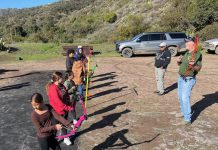Where would you bury a treasure on Catalina Island?
If you had millions of dollars worth of gold, silk, ivory and gems and you had to temporarily dispose of them, where would you put them?
This was precisely the envious predicament that a certain privateer named Sir Thomas Cavendish may well have faced many a year ago with ill-gotten booty he had acquired from a Spanish galleon named the Santa Ana.
Where would you bury a treasure on Catalina Island?
If you had millions of dollars worth of gold, silk, ivory and gems and you had to temporarily dispose of them, where would you put them?
This was precisely the envious predicament that a certain privateer named Sir Thomas Cavendish may well have faced many a year ago with ill-gotten booty he had acquired from a Spanish galleon named the Santa Ana.
Whether or not Cavendish ever found a suitable place to stash his goods—or whether or not he even looked for one here—the story of how he captured the Santa Ana and made off with a record-breaking haul is now the stuff of legend.
Cavendish’s capture of the Santa Ana was his “crowning achievement” in a long litany of such maritime indiscretions, all of which were sanctioned by the British Crown.
It’s been said that Cavendish was the very first person to circumnavigate the globe with the specific intention of doing so.
A handful of other explorers—including Magellan, Drake and Portola—had preceded him in this accomplishment, but going around the earth hadn’t really been their intention.
Whatever Cavendish’s designs, after entering the Pacific Ocean in 1587, he and his crew looted and pillaged their way up the coast of South America, sinking ships and burning towns—all of which were legitimate targets because they belonged to the hated Spanish.
After one fine day of plundering, a pilot from a captured Spanish ships offered up the intelligence that a Manila galleon, loaded with treasure, was expected on the coast of New Spain in the Fall. Cavendish and his crew sailed their vessels, the Desire and the Content, north and positioned themselves off the coast of Cabo San Lucas.
Then they waited.
Soon enough, they were rewarded with the sighting of the galleon Santa Ana, already damaged from an encounter with a typhoon in the western Pacific.
To make matters worse for the Santa Ana, her cannons had all been removed in order to make more room for treasure, leaving her all the more vulnerable.
The battle began and despite the ship’s handicaps, her crew put up a respectable fight.
The battle lasted several hours with Cavendish firing cannon “fire balls” and grape shot into the hapless galleon.
The Spaniards could only fight back with small arms.
When the Santa Ana finally began to sink, the Spanish crew stuck their colors and surrendered.
Incredibly, the crew of the Santa Ana was not only spared their lives, but were put ashore with enough food, water and armaments so that they could survive until the next ship came along. (The Spanish survivors ended up repairing the damaged Santa Ana and continued their voyage to Acapulco).
The treasure plundered from the Santa Ana represented a record haul for the Pacific, something on the order of two million pesos worth of valuables.
From there, events become a little hazy from an historical perspective, but legend says that before continuing their voyage across the Pacific, the privateers made their way north, possibly to Catalina, to stash some of their treasure.
Cavendish survived his circumnavigation and was even knighted by Elizabeth I upon his return. (Cavendish tobacco, a popular style of pipe tobacco, is even named after him).
Back on dry land but itching for glory, Cavendish eventually set sail from England with the goal of doing the pillage-and–circumnavigation thing again, but this time his luck ran out.
In fact, he didn’t even survive the first leg of his trip and died of “unknown causes” somewhere in the South Atlantic, possibly Ascension Island.
We can speculate that one of the reasons for Cavendish’s second voyage was to go dig up all that treasure he may have buried during his first voyage, including here on Catalina.
If that was his intention, we’ll never know because he carried the secret with him to the grave, dead men telling no tales and all that.
So where might Cavendish have buried this treasure on Catalina (assuming he did so)?
I’ve always felt that one of the most romanticized places would be in the cave running through Long Point. Every time I hike through there in my swim fins and booties I imagine a decaying, disintegrating iron and wooden chest just beneath my toes, brimming with shiny gold doubloons.
Of course, in reality such a place would probably be a poor choice due to its proximity to the sea’s corrosive influence. Up higher and drier would be a better bet, which pretty much opens up the whole Island above the high tide mark. Barring Long Point, the best place would be near a prominent physical landmark, such as on the bluff at Little Gibraltar or on Indian Rock at Emerald Bay.
How about you? Where would you bury a treasure on Catalina Island?










